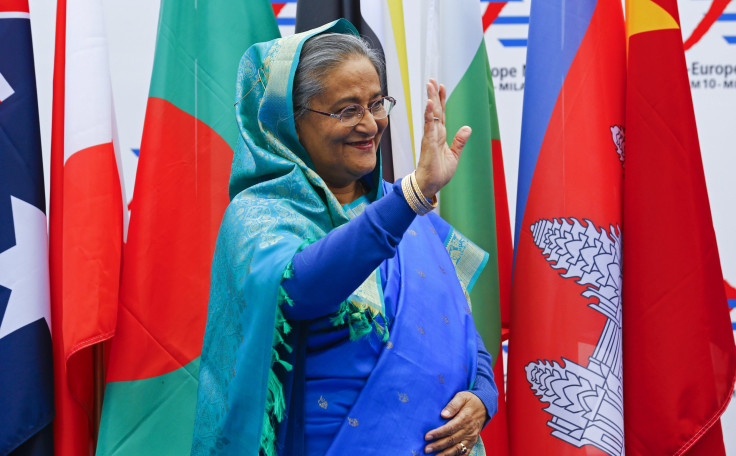Bangladesh Economy Outperforming India And Much Of Asia

KEY POINTS
- In January 2020 alone, expatriate Bangladeshis sent $1.63 billion home
- Since 2009, Bangladesh’s economy has expanded by 188%.
- HSBC Bank forecast that Bangladesh will become the world’s 26th largest economy by 2030
As U.S. President Donald Trump prepares for his historic trip to India next week, he might not realize that neighboring Bangladesh – once derided as a “basket case” by Henry Kissinger – is enjoying an economic boom and outperforming its giant neighbor.
Bangladesh Prime Minister Sheikh Hasina even compared her long-suffering nation to the economic powerhouse of Singapore.
“The political and economic conditions have made it easier for them [Singapore government] to achieve development,” she said, noting that Bangladesh has to cope with chronic political violence and overpopulation.
Nonetheless, she noted, Bangladesh has somehow improved the lives of tens of millions of people and is now on an equal footing with many of its Asian neighbors.
“We are ahead of the countries not only in South Asia, but also those in Southeast Asia. We want to build a Singapore out of Bangladesh, but actually we are economically much stronger than Singapore. This is the least I can claim,” she said.
Bangladesh has not only delivered high economic growth, but has also witnessed a large increase in remittance payments from its millions of immigrants in the Middle East, Southeast Asia, Britain and North America, helping it to maintain a low current account deficit.
In January 2020, expatriate Bangladeshis sent $1.63 billion home. If the rate continues, remittance will reach $20 billion by the end of the fiscal year.
Since 2009, Bangladesh’s economy has expanded by 188%. Over that time, 15.8 million people escaped poverty, the overall poverty rate plunged from 31.5% to 21.8% and per capita income almost tripled.
HSBC Bank has forecast that Bangladesh will become the world’s 26th largest economy by 2030 (up from 42nd place as of late 2018).
“The starting point for a country is a key part of its potential growth. It is very clear that a country such as Bangladesh has far more potential growth than one like Norway, which is far richer,” HSBC said.
HSBC projected Bangladesh’s real gross domestic product growth will amount to 7.1% per year through 2030 -- at that point it will boast a $700 billion economy (up from $300 billion now).
International investors have been watching Bangladesh closely. Since 2018, net foreign direct investment has mushroomed by 42.9%.
Sanjiv Shankaran of the Times of India wrote that India could learn something from Bangladesh’s economic renaissance.
“Bangladesh in the last couple of decades has emerged as a key hub for apparel exports,” he wrote. “To put this in context, about three decades ago its exports of footwear and apparel accounted for less than 1% of the global exports in these products. Now, it’s about 7%, behind only China and Vietnam. These sectors employ about 3.6 million people [in Bangladesh], of whom over half are women.”
Shankaran also said that a “low income” country such as Bangladesh offers “relevant lessons“ on how to attract more global value chains to India. “In popular imagination, Bangladesh may be a basket case, still sending economic migrants into India,” he wrote. “This view masks the changes [going on] there.”
In the almost 50 years since its war of liberation in 1971, Bangladesh has accomplished significant progress in economic and social indicators, leaving its former master Pakistan far behind.
“If the economic growth rates of India and Bangladesh diverge for a few more years, Bangladesh will surpass India in per capita GDP terms,” he added.
Shankaran conceded however that everything is not rosy in Bangladesh. For one thing, the economy depends too much on garment exports and the banking system is burdened by bad loans amounting to almost 9% of GDP.
“Yet, Bangladesh’s policies offer some lessons for India and it will be our loss to ignore them,” he added.
Efosa Ojomo, a senior research fellow at the Christensen Institute, a nonprofit, nonpartisan think tank based in Boston, commented that “much of Bangladesh’s growth over the past decade has come from the nation transforming itself into a garment manufacturing hub.”
Bangladesh currently exports about $38 billion worth of textiles and garments every year -- by next year, the government’s projects that figure could reach $50 billion.
“Bangladesh can continue its economic ascendancy by investing in market-creating innovations,” Ojoma wrote. “If the government and entrepreneurs within the country focus on making products and services more affordable for Bangladesh’s 166 million people, in areas such as healthcare, food production, manufacturing, insurance, and entertainment, these new markets which will lead to more sustainable jobs.”
The Asian Development Bank, or ADB, projected that Bangladesh will deliver 8% GDP growth, the highest in Asia, in the current fiscal year. (India’s projected growth rate is about 5%, an 11-year low).
“ADB's outlook indicates that Bangladesh is likely to continue as the fastest growing economy in Asia and the Pacific,” said ABD Country Director Manmohan Parkash.
Parkash cited the country’s ongoing growth to “buoyant exports, robust private consumption with higher remittances, accommodative monetary policy, ongoing reform to improve business climate for private investment and public infrastructure investment.”
Prakash added that despite weaker global growth, “favorable trade prospects are expected to continue [in Bangladesh]. Exports and remittances are likely to be further strengthened. Strong public investment due to continued policy environment and expediting implementation of large infrastructure projects are also envisaged.”
© Copyright IBTimes 2024. All rights reserved.




















